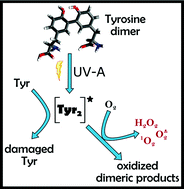Photochemistry of tyrosine dimer: when an oxidative lesion of proteins is able to photoinduce further damage†
Abstract
The tyrosine dimer (Tyr2), a covalent bond between two tyrosines (Tyr), is one of the most important modifications of the oxidative damage of proteins. This compound is increasingly used as a marker of aging, stress and pathogenesis. At physiological pH, Tyr2 is able to absorb radiation at wavelengths significantly present in the solar radiation and artificial sources of light. As a result, when Tyr2 is formed in vivo, a new chromophore appears in the proteins. Despite the biomedical importance of Tyr2, the information of its photochemical properties is limited due to the drawbacks of its synthesis. Therefore, in this work we demonstrate that at physiological pH, Tyr2 undergoes oxidation upon UV excitation yielding different products which conserve the dimeric structure. During its photodegradation different reactive oxygen species, like hydrogen peroxide, superoxide anion and singlet oxygen, are produced. Otherwise, we demonstrated that Tyr2 is able to sensitize the photodegradation of tyrosine. The results presented in this work confirm that Tyr2 can act as a potential photosensitizer, contributing to the harmful effects of UV-A radiation on biological systems.



 Please wait while we load your content...
Please wait while we load your content...